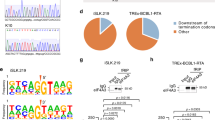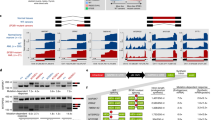Abstract
Oncolytic human herpes simplex virus type 1 (HSV-1) shows promising treatment efficacy in late-stage clinical trials. The anticancer activity of oncolytic viruses relies on deregulated pathways in cancer cells, which make them permissive to oncolysis. To identify pathways that restrict HSV-1 KM100-mediated oncolysis, this study used a pooled genome-wide short hairpin RNA library and found that depletion of the splicing factor arginine-rich splicing factor 2 (SRSF2) leads to enhanced cytotoxicity of breast cancer cells by KM100. Serine/arginine-rich (SR) proteins are a family of RNA-binding phosphoproteins that control both constitutive and alternative pre-mRNA splicing. Further characterization showed that KM100 infection of HS578T cells under conditions of low SRSF2 leads to pronounced apoptosis without a corresponding increase in virus replication. As DNA topoisomerase I inhibitors can limit the phosphorylation of SRSF2, we combined a topoisomerase I inhibitor chemotherapeutic with KM100 and observed synergistic anticancer effect in vitro and prolonged survival of tumor-bearing mice in vivo.
This is a preview of subscription content, access via your institution
Access options
Subscribe to this journal
Receive 50 print issues and online access
$259.00 per year
only $5.18 per issue
Buy this article
- Purchase on Springer Link
- Instant access to full article PDF
Prices may be subject to local taxes which are calculated during checkout







Similar content being viewed by others
References
Russell SJ, Peng K-W, Bell JC . Oncolytic virotherapy. Nat Biotechnol 2012; 30: 658–670.
Workenhe ST, Mossman KL . Oncolytic virotherapy and immunogenic cancer cell death: sharpening the sword for improved cancer treatment strategies. Mol Ther 2013; 22: 251–256.
Martuza RL, Malick A, Markert JM, Ruffner KL, Coen DM . Experimental therapy of human glioma by means of a genetically engineered virus mutant. Science 1991; 252: 854–856.
Hummel J, Safroneeva E, Mossman K . The role of ICP0-null HSV-1 and interferon signaling defects in the effective treatment of breast adenocarcinoma. Mol Ther 2005; 12: 1101–1110.
Workenhe ST, Simmons G, Pol JG, Lichty BD, Halford WP, Mossman KL . Immunogenic HSV-mediated oncolysis shapes the antitumor immune response and contributes to therapeutic efficacy. Mol Ther 2014; 22: 123–131.
Workenhe ST, Pol JG, Lichty BD, Cummings DT, Mossman KL . Combining oncolytic HSV-1 with immunogenic cell death-inducing drug mitoxantrone breaks cancer immune tolerance and improves therapeutic efficacy. Cancer Immunol Res 2013; 1: 309–319.
Diallo J-S, Boeuf FL, Lai F, Cox J, Vaha-Koskela M, Abdelbary H et al. A high-throughput pharmacoviral approach identifies novel oncolytic virus sensitizers. Mol Ther 2010; 18: 1123–1129.
Sobol PT, Boudreau JE, Stephenson K, Wan Y, Lichty BD, Mossman KL . Adaptive antiviral immunity is a determinant of the therapeutic success of oncolytic virotherapy. Mol Ther 2010; 19: 335–344.
Twyffels L, Gueydan C, Kruys V . Shuttling SR proteins: more than splicing factors. FEBS J 2011; 278: 3246–3255.
Anczuków O, Rosenberg AZ, Akerman M, Das S, Zhan L, Karni R et al. The splicing factor SRSF1 regulates apoptosis and proliferation to promote mammary epithelial cell transformation. Nat Struct Mol Biol 2012; 19: 220–228.
Walsh D, Mohr I . Viral subversion of the host protein synthesis machinery. Nat Rev Microbiol 2011; 9: 860–875.
Walsh D, Mohr I . Phosphorylation of eIF4E by Mnk-1 enhances HSV-1 translation and replication in quiescent cells. Genes Dev 2004; 18: 660–672.
Moorman NJ, Shenk T . Rapamycin-resistant mTORC1 kinase activity is required for herpesvirus replication. J Virol 2010; 84: 5260–5269.
Rossi F, Labourier E, Forné T, Divita G, Derancourt J, Riou JF et al. Specific phosphorylation of SR proteins by mammalian DNA topoisomerase I. Nature 1996; 381: 80–82.
Pilch B, Allemand E, Facompré M, Bailly C, Riou JF, Soret J et al. Specific inhibition of serine- and arginine-rich splicing factors phosphorylation, spliceosome assembly, and splicing by the antitumor drug NB-506. Cancer Res 2001; 61: 6876–6884.
Soret J, Gabut M, Dupon C, Kohlhagen G, Stévenin J, Pommier Y et al. Altered serine/arginine-rich protein phosphorylation and exonic enhancer-dependent splicing in mammalian cells lacking topoisomerase I. Cancer Res 2003; 63: 8203–8211.
Ciomei M, Croci V, Ciavolella A, Ballinari D, Pesenti E . Antitumor efficacy of edotecarin as a single agent and in combination with chemotherapy agents in a xenograft model. Clin Cancer Res 2006; 12: 2856–2861.
Solier S, Barb J, Zeeberg BR, Varma S, Ryan MC, Kohn KW et al. Genome-wide analysis of novel splice variants induced by topoisomerase I poisoning shows preferential occurrence in genes encoding splicing factors. Cancer Res 2010; 70: 8055–8065.
Moffat J, Grueneberg DA, Yang X, Kim SY, Kloepfer AM, Hinkle G et al. A lentiviral RNAi library for human and mouse genes applied to an arrayed viral high-content screen. Cell 2006; 124: 1283–1298.
Ketela T, Heisler LE, Brown KR, Ammar R, Kasimer D, Surendra A et al. A comprehensive platform for highly multiplexed mammalian functional genetic screens. BMC Genom 2011; 12: 213.
Mahoney DJ, Stojdl DF . A call to arms: using RNAi screening to improve oncolytic viral therapy. Cytokine Growth Factor Rev 2010; 21: 161–167.
Edmond V, Moysan E, Khochbin S, Matthias P, Brambilla C, Brambilla E et al. Acetylation and phosphorylation of SRSF2 control cell fate decision in response to cisplatin. EMBO J 2010; 30: 510–523.
Karni R, de Stanchina E, Lowe SW, Sinha R, Mu D, Krainer AR . The gene encoding the splicing factor SF2/ASF is a proto-oncogene. Nat Struct Mol Biol 2007; 14: 185–193.
Tahara M, Inoue T, Miyakura Y, Horie H, Yasuda Y, Fujii H et al. Cell diameter measurements obtained with a handheld cell counter could be used as a surrogate marker of G2/M arrest and apoptosis in colon cancer cell lines exposed to SN-38. Biochem Biophys Res Commun 2013; 434: 753–759.
Ueno M, Nonaka S, Yamazaki R, Deguchi N, Murai M . SN-38 induces cell cycle arrest and apoptosis in human testicular cancer. Eur Urol 2002; 42: 390–397.
Ilkow CS, Swift SL, Bell JC, Diallo J-S . From scourge to cure: tumour-selective viral pathogenesis as a new strategy against cancer. PLoS Pathogen 2014; 10: e1003836.
Stickeler E, Kittrell F, Medina D, Berget SM . Stage-specific changes in SR splicing factors and alternative splicing in mammary tumorigenesis. Oncogene 1999; 18: 3574–3582.
Quidville V, Alsafadi S, Goubar A, Commo F, Scott V, Pioche-Durieu C et al. Targeting the deregulated spliceosome core machinery in cancer cells triggers mTOR blockade and autophagy. Cancer Res 2013; 73: 2247–2258.
Edmond V, Merdzhanova G, Gout S, Brambilla E, Gazzeri S, Eymin B . A new function of the splicing factor SRSF2 in the control of E2F1-mediated cell cycle progression in neuroendocrine lung tumors. Cell Cycle 2013; 12: 1267–1278.
Zhang J, Manley JL . Misregulation of pre-mRNA alternative splicing in cancer. Cancer Discov 2013; 3: 1228–1237.
Bonnal S, Vigevani L, Valcárcel JVA . The spliceosome as a target of novel antitumour drugs. Nat Rev Drug Discov 2012; 11: 847–859.
Vanderbeeken M-C, Aftimos PG, Awada A . Topoisomerase inhibitors in metastatic breast cancer: overview of current practice and future development. Curr Breast Cancer Rep 2013; 5: 31–41.
Kümler I, Brünner N, Stenvang J, Balslev E, Nielsen DL . A systematic review on topoisomerase 1 inhibition in the treatment of metastatic breast cancer. Breast Cancer Res Treat 2013; 138: 347–358.
Bolyard C, Yoo JY, Wang PY, Saini U, Rath KS, Cripe TP et al. Doxorubicin synergizes with 34.5ENVE to enhance antitumor efficacy against metastatic ovarian cancer. Clin Cancer Res 2014; 20: 6479–6494.
Rovero S, Amici A, Di Carlo E, Bei R, Nanni P, Quaglino E et al. DNA vaccination against rat her-2/Neu p185 more effectively inhibits carcinogenesis than transplantable carcinomas in transgenic BALB/c mice. J Immunol 2000; 165: 5133–5142.
Mossman KL, Smiley JR . Truncation of the C-terminal acidic transcriptional activation domain of herpes simplex virus VP16 renders expression of the immediate-early genes almost entirely dependent on ICP0. J Virol 1999; 73: 9726–9733.
Moffat J, Grueneberg DA, Yang X, Kim SY, Kloepfer AM, Hinkle G et al. A lentiviral RNAi library for human and mouse genes applied to an arrayed viral high-content screen. Cell 2006; 124: 1283–1298.
Chou T-C, Talalay P . Quantitative analysis of dose–effect relationships: the combined effects of multiple drugs or enzyme inhibitors. Adv Enzyme Regul 1984; 22: 27–55.
Cheema TA, Kanai R, Kim GW, Wakimoto H, Passer B, Rabkin SD et al. Enhanced antitumor efficacy of low-dose etoposide with oncolytic herpes simplex virus in human glioblastoma stem cell xenografts. Clin Cancer Res 2011; 17: 7383–7393.
Workenhe ST, Wadowska DW, Wright GM, Kibenge MJ, Kibenge FS . Demonstration of infectious salmon anaemia virus (ISAV) endocytosis in erythrocytes of Atlantic salmon. Virol J 2007; 4: 13.
Workenhe ST, Hori TS, Rise ML, Kibenge MJ, Kibenge FS . Infectious salmon anaemia virus (ISAV) isolates induce distinct gene expression responses in the Atlantic salmon (Salmo salar macrophage/dendritic-like cell line TO, assessed using genomic techniques. Mol Immunol 2009; 46: 2955–2974.
Acknowledgements
These studies were supported by operating grants to KLM from the Cancer Research Society and the Canadian Cancer Society Research Institute.
Author information
Authors and Affiliations
Corresponding authors
Ethics declarations
Competing interests
The authors declare no conflict of interest.
Additional information
Supplementary Information accompanies this paper on the Oncogene website
Supplementary information
Rights and permissions
About this article
Cite this article
Workenhe, S., Ketela, T., Moffat, J. et al. Genome-wide lentiviral shRNA screen identifies serine/arginine-rich splicing factor 2 as a determinant of oncolytic virus activity in breast cancer cells. Oncogene 35, 2465–2474 (2016). https://doi.org/10.1038/onc.2015.303
Received:
Revised:
Accepted:
Published:
Issue Date:
DOI: https://doi.org/10.1038/onc.2015.303
This article is cited by
-
De novo necroptosis creates an inflammatory environment mediating tumor susceptibility to immune checkpoint inhibitors
Communications Biology (2020)
-
Proteomic analysis of BmN cell lipid rafts reveals roles in Bombyx mori nucleopolyhedrovirus infection
Molecular Genetics and Genomics (2017)



